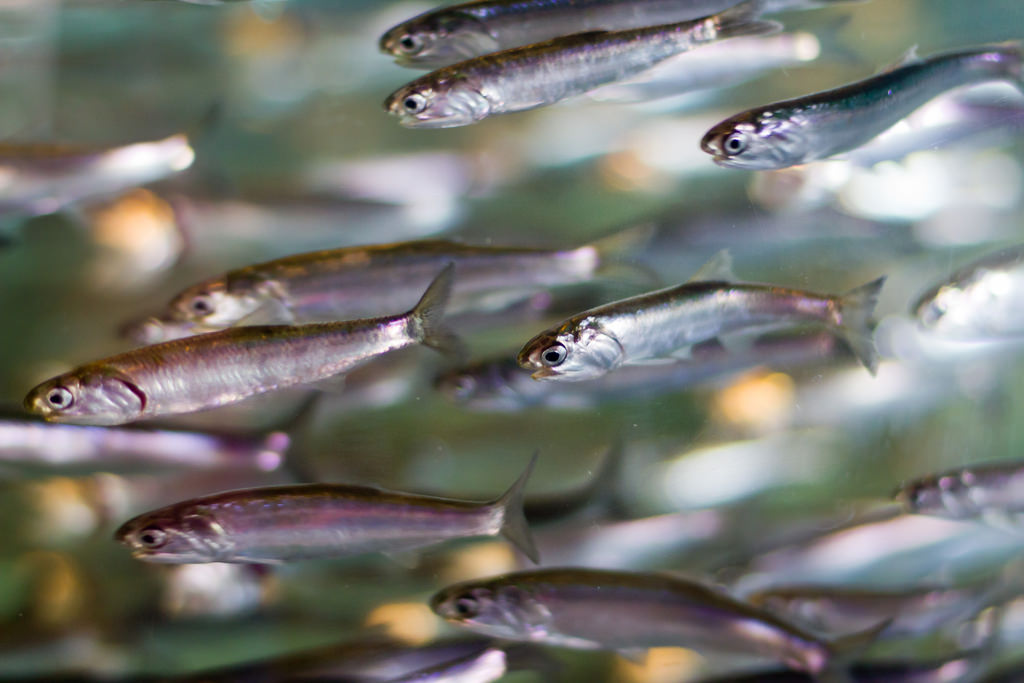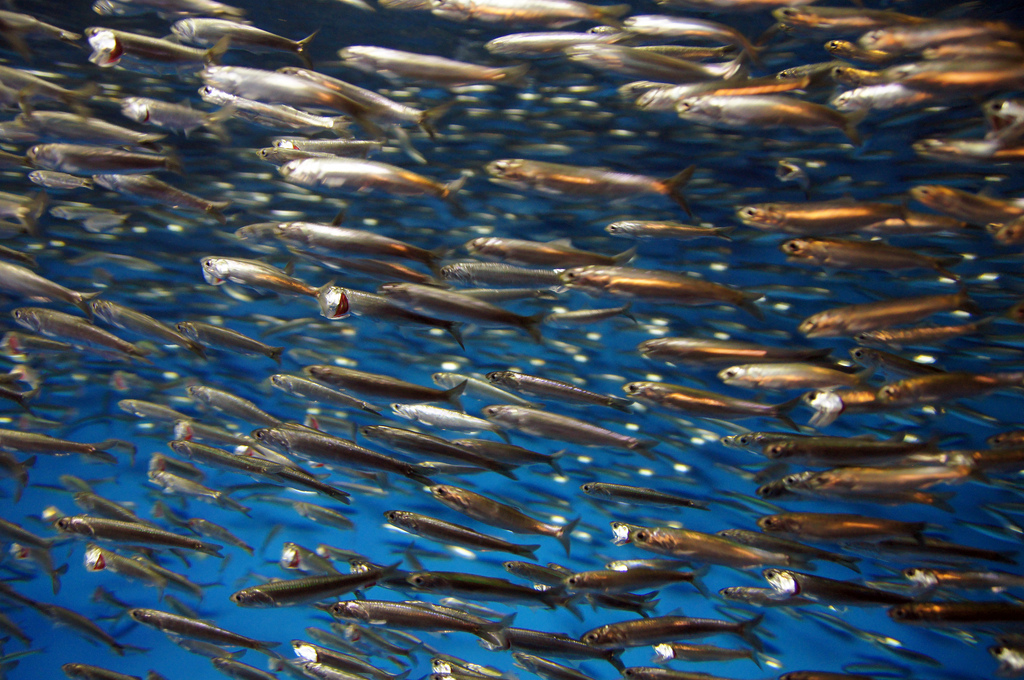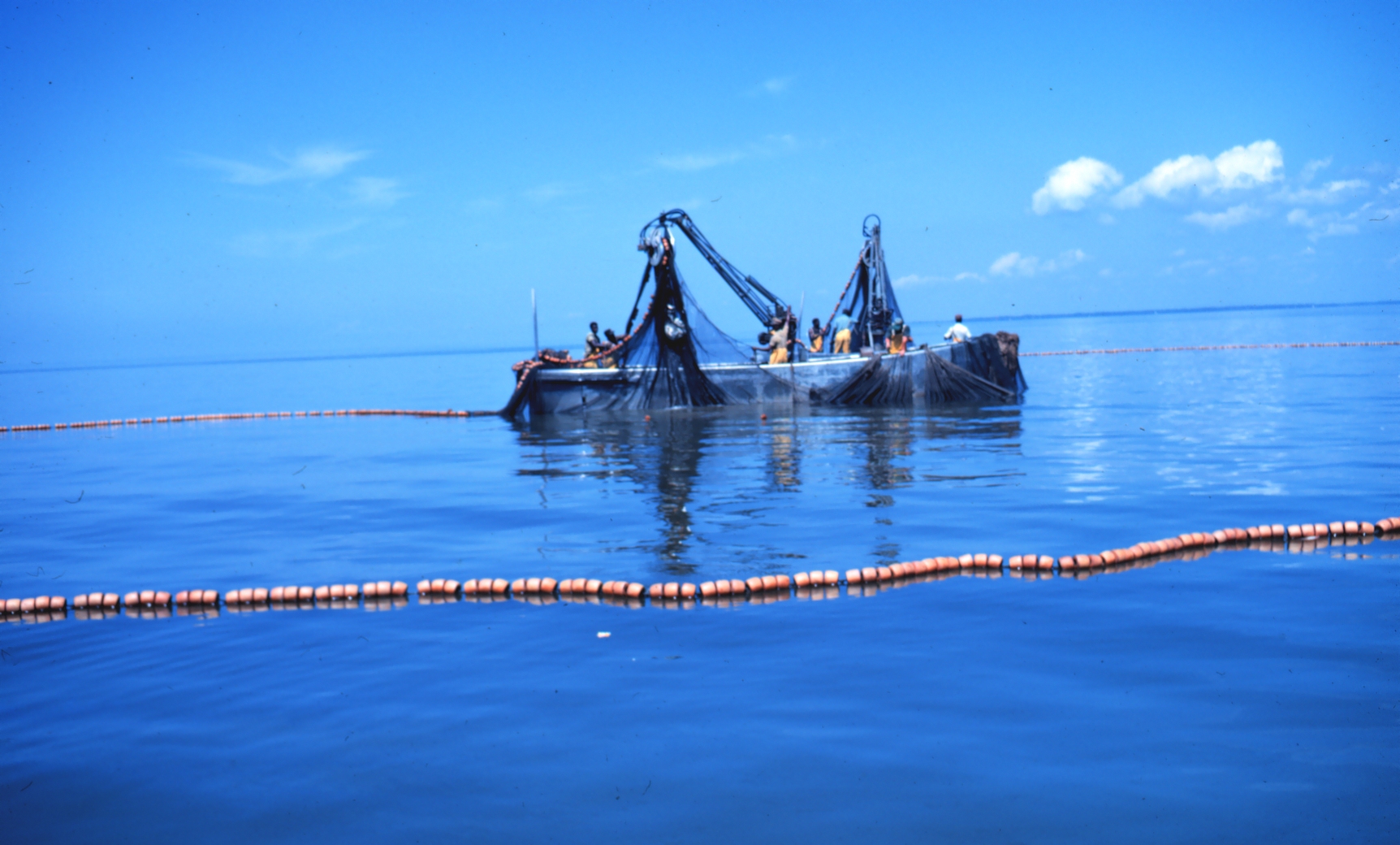Engraulis mordax
North Coast (Oregon Border to Point Arena)
North Central Coast (South of Point Arena to Half Moon Bay)
Central Coast (South of Half Moon Bay to Point Conception)
Santa Barbara (Point Conception to Point Dume)
South Coast (Point Dume to Mexico border)
Oily fish
Wild caught

The Science

Taxonomic description
- Small and thin- typically grow up to seven inches. [1, 2, 3]
- Has a large mouth and a long, protruding snout. [1,2]
- Blue-green color on top, and lustrous silver below. [1,2,4]
- Has a silver stripe along its side in adulthood. [1,2]
Distribution
- Found along the West Coast of North America from British Columbia down to the Baja California, Mexico, as well as the Gulf of California. [4, 5]
- In the United States, this species is subdivided into two populations, one sub-population off of Oregon and Washington and the other ranging from California to Baja, California. [1,2]
Life history
- Has a short life cycle- can spawn at two years and live four to seven years. [1,2,4]
- Naturally high mortality rate, 45-55% of populations die of natural causes a year. [1,2]
- Spawns year-round, but most frequently in the winter and spring. [2,4,6]
- The eggs are released in batches every 7-10 days, and hatching depends on the temperature of the water- typically between 2-4 days. [2,4]
- This species fertilizes through broadcast spawning. [4]
Habitat
- Lives in pelagic areas, usually within 30km from the shore. [6]
- Is a critical aspect of the food web. [1,4]
- Serves as food for many species of fish, marine mammals, and birds. [4]
- Hosts endoparasites. [4]
- For protection against predators, this species forms schools. [4]
- Though it is a filter feeder, it uses scent to find prey. [8]
- A study has concluded that it can mistake the smell of plastics smells for food. [8]
The Fishery

Seasonal availability
- Available year-round. [1]
Regulatory and managing authority
- Managed federally by the NOAA fisheries and, as established by the Magnuson-Stevens Act, the Pacific Fishery Management Council (PFMC) through the Coastal Pelagic Species Fishery Management Plan (CPSFMP). [1]
- As established by the Marine Life Management Act, the California Fish and Game Commission (CFGC) regulates the fishery in state waters, and the California Department of Fish and Wildlife (CDFW) collects data and helps enforce FMP management rules for this fishery through the Pelagic Fisheries and Ecosystems Program. [12,14]
- The California Wetfish Producers Association combines input from the industry and government entities to inform regulatory and management measures for this fishery. [13]
Gear type
- Predominantly caught with purse seines, but also with lampara nets. [6,9]
Status of the fishery
- Population levels are unknown, but thought to be abundant. [1,4]
- Stock assessments are not done on subpopulations, but data to help monitor populations has been collected. [1]
- Both northern and central sub-populations have defined overfishing limits. [1]
- Population is considered to be stable and of least concern by IUCN Red List. [4,6]
- Its large distribution, including in Marine Protected Areas, mitigates threat. [6]
Potential ecosystem impacts
- Because the gear uses functions near the surface, there is minimal habitat destruction. [1]
The Seafood

Edible portions
- The entire body can be eaten after removing the head and guts. [7]
- The bones are also edible. [7]
Description of meat
- Fresh anchovies are soft, canned anchovies are firm. [2]
- The color of the meat depends on the way it is being used:
- Due to salt-curing, canned anchovies are light red. [2]
- Fresh is gray when raw, off-white when cooked. [2]
Culinary uses
- Can be eaten fresh, but is most commonly preserved in cans or jars. [10,11]

- Commonly used in sauces and dressings, such as Caesar salad dressing. [10]
- Can be easily fried, as shown above. [7]
- Recipe ideas can be found on FoodNetwork. [11]
Nutritional information
- Nutrition facts given are for a 100-gram serving. [2]
- Good source of calcium, iron, niacin, phosphorus, and selenium. [2]
- High in cholesterol. [2]
Toxicity report
- Because anchovies are filter feeders, it is important to make sure the guts are removed, and the fish is rinsed before cooking. [7]
- Microplastics contaminating anchovies' diet may also have impacts on human consumption. [8]
Seasonal availability
- Year round. [2]
References
[1] NOAA Fisheries. Northern Anchovy. Web. https://www.fisheries.noaa.gov/species/northern-anchovy. Accessed: 29 November 2018
[2] FishWatch. 2017. Northern Anchovy. Web. https://www.fishwatch.gov/profiles/northern-anchovy. Accessed: 29 November 2018
[3] Monterey Bay Aquarium. 2018. Northern anchovy. Web. http://www.montereybayaquarium.org/animal-guide/fishes/northern-anchovy. Accessed: 29 November 2018
[4] Davis, T., E. DelaTorre, and A. Raub. Year. Animal Diversity Web: Northern Anchovy. Web. https://animaldiversity.org/accounts/Engraulis_mordax/. Accessed: 29 November 2018
[5] Oceana. Northern Anchovy. Web. https://usa.oceana.org/responsible-fishing/northern-anchovy. Accessed: 29 November 2018
[6]Iwamoto, T., Eschmeyer, W., Alvarado, J. 2010. Engraulis mordax. The IUCN Red List of Threatened Species. Web. https://www.iucnredlist.org/species/183856/8189272#habitat-ecology. Accessed: 29 November 2018
[7] FreshCatch. Northern Anchovy. Web. https://www.tryfreshcatch.com/anchovies/. Accessed: 6 December 2018
[8] Savoca, Matthew. 2017. Bait and Switch: Anchovies Eat Plastic Because It Smells Like Prey. Web. https://www.scientificamerican.com/article/bait-and-switch-anchovies-eat.... Accessed: 7 December 2018
[9] Environmental Defense Fund. Year. EDF Seafood Selector. Web. http://seafood.edf.org/anchovy. Accessed: 7 December 2018
[10] Busch, Sandi. 2018. What Are the Health Benefits of Anchovies. Web. https://healthyeating.sfgate.com/health-benefits-anchovies-2748.html. Accessed: 10 January 2019
[11] Hirsch, J.M. 2011. Off the Beaten Aisle: Anchovies. Web. https://www.foodnetwork.com/fn-dish/recipes/2011/08/how-to-eat-anchovies. Accessed: 10 January 2019
[12] Marine Life Management Act. n.d. California Department of Fish and Wildlife. Web. https://wildlife.ca.gov/Conservation/Marine/MLMA. Accessed 24 August 2020.
[13] California Wetfish Producers Association. 2013. California Wetfish Producers Association. Web. https://californiawetfish.org/. Accessed 2 December 2020.
[14] Overview of the Pelagic Fisheries and Ecosystems Program. n.d. California Department of Fish and Wildlife. Web. https://wildlife.ca.gov/Conservation/Marine/Pelagic#52132542-overview. Accessed 9 December 2020.
[15] Nieuwendijk, S. flickr. 2012. Anchovies. Digital image. Web. https://flickr.com/photos/stijnnieuwendijk/7342097312. Accessed 18 February 2021.
